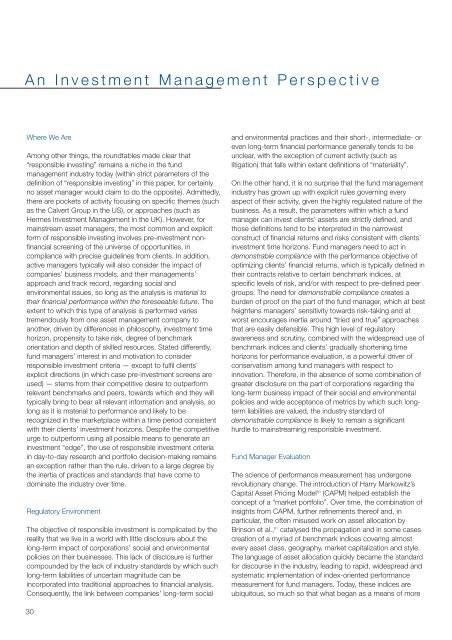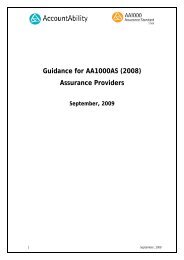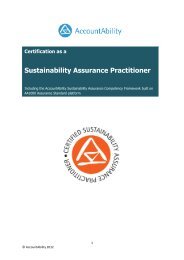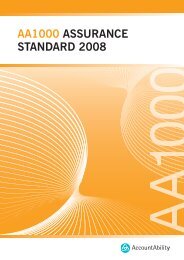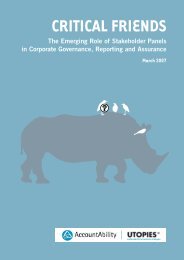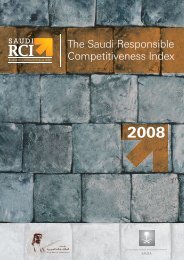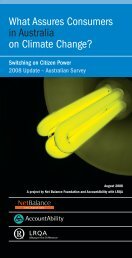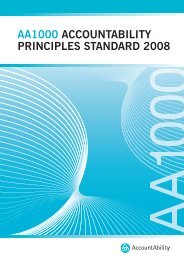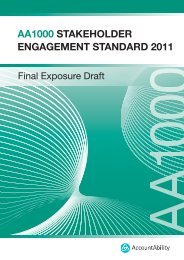Mainstreaming Responsible Investment - AccountAbility
Mainstreaming Responsible Investment - AccountAbility
Mainstreaming Responsible Investment - AccountAbility
Create successful ePaper yourself
Turn your PDF publications into a flip-book with our unique Google optimized e-Paper software.
An <strong>Investment</strong> Management Perspective<br />
Where We Are<br />
Among other things, the roundtables made clear that<br />
“responsible investing” remains a niche in the fund<br />
management industry today (within strict parameters of the<br />
definition of “responsible investing” in this paper, for certainly<br />
no asset manager would claim to do the opposite). Admittedly,<br />
there are pockets of activity focusing on specific themes (such<br />
as the Calvert Group in the US), or approaches (such as<br />
Hermes <strong>Investment</strong> Management in the UK). However, for<br />
mainstream asset managers, the most common and explicit<br />
form of responsible investing involves pre-investment nonfinancial<br />
screening of the universe of opportunities, in<br />
compliance with precise guidelines from clients. In addition,<br />
active managers typically will also consider the impact of<br />
companies’ business models, and their managements’<br />
approach and track record, regarding social and<br />
environmental issues, so long as the analysis is material to<br />
their financial performance within the foreseeable future. The<br />
extent to which this type of analysis is performed varies<br />
tremendously from one asset management company to<br />
another, driven by differences in philosophy, investment time<br />
horizon, propensity to take risk, degree of benchmark<br />
orientation and depth of skilled resources. Stated differently,<br />
fund managers’ interest in and motivation to consider<br />
responsible investment criteria — except to fulfil clients’<br />
explicit directions (in which case pre-investment screens are<br />
used) — stems from their competitive desire to outperform<br />
relevant benchmarks and peers, towards which end they will<br />
typically bring to bear all relevant information and analysis, so<br />
long as it is material to performance and likely to be<br />
recognized in the marketplace within a time period consistent<br />
with their clients’ investment horizons. Despite the competitive<br />
urge to outperform using all possible means to generate an<br />
investment “edge”, the use of responsible investment criteria<br />
in day-to-day research and portfolio decision-making remains<br />
an exception rather than the rule, driven to a large degree by<br />
the inertia of practices and standards that have come to<br />
dominate the industry over time.<br />
Regulatory Environment<br />
The objective of responsible investment is complicated by the<br />
reality that we live in a world with little disclosure about the<br />
long-term impact of corporations’ social and environmental<br />
policies on their businesses. This lack of disclosure is further<br />
compounded by the lack of industry standards by which such<br />
long-term liabilities of uncertain magnitude can be<br />
incorporated into traditional approaches to financial analysis.<br />
Consequently, the link between companies’ long-term social<br />
and environmental practices and their short-, intermediate- or<br />
even long-term financial performance generally tends to be<br />
unclear, with the exception of current activity (such as<br />
litigation) that falls within extant definitions of “materiality”.<br />
On the other hand, it is no surprise that the fund management<br />
industry has grown up with explicit rules governing every<br />
aspect of their activity, given the highly regulated nature of the<br />
business. As a result, the parameters within which a fund<br />
manager can invest clients’ assets are strictly defined, and<br />
those definitions tend to be interpreted in the narrowest<br />
construct of financial returns and risks consistent with clients’<br />
investment time horizons. Fund managers need to act in<br />
demonstrable compliance with the performance objective of<br />
optimizing clients’ financial returns, which is typically defined in<br />
their contracts relative to certain benchmark indices, at<br />
specific levels of risk, and/or with respect to pre-defined peer<br />
groups. The need for demonstrable compliance creates a<br />
burden of proof on the part of the fund manager, which at best<br />
heightens managers’ sensitivity towards risk-taking and at<br />
worst encourages inertia around “tried and true” approaches<br />
that are easily defensible. This high level of regulatory<br />
awareness and scrutiny, combined with the widespread use of<br />
benchmark indices and clients’ gradually shortening time<br />
horizons for performance evaluation, is a powerful driver of<br />
conservatism among fund managers with respect to<br />
innovation. Therefore, in the absence of some combination of<br />
greater disclosure on the part of corporations regarding the<br />
long-term business impact of their social and environmental<br />
policies and wide acceptance of metrics by which such longterm<br />
liabilities are valued, the industry standard of<br />
demonstrable compliance is likely to remain a significant<br />
hurdle to mainstreaming responsible investment.<br />
Fund Manager Evaluation<br />
The science of performance measurement has undergone<br />
revolutionary change. The introduction of Harry Markowitz’s<br />
Capital Asset Pricing Model 60 (CAPM) helped establish the<br />
concept of a “market portfolio”. Over time, the combination of<br />
insights from CAPM, further refinements thereof and, in<br />
particular, the often misused work on asset allocation by<br />
Brinson et al., 61 catalysed the propagation and in some cases<br />
creation of a myriad of benchmark indices covering almost<br />
every asset class, geography, market capitalization and style.<br />
The language of asset allocation quickly became the standard<br />
for discourse in the industry, leading to rapid, widespread and<br />
systematic implementation of index-oriented performance<br />
measurement for fund managers. Today, these indices are<br />
ubiquitous, so much so that what began as a means of more<br />
30


